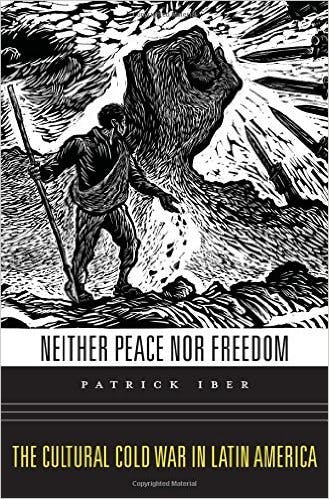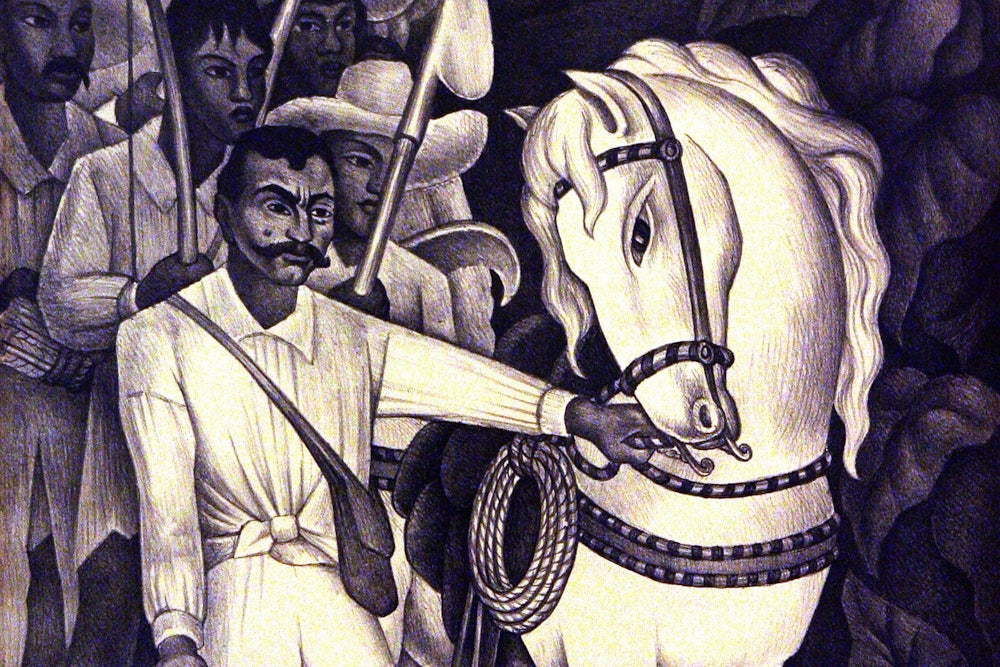Over halfway through Roberto Bolaño’s The Savage Detectives, Ulises Lima disappears. The character (modeled on Bolaño’s close friend, Mario Santiago) fortuitously ends up in a group of Mexican poets traveling to Nicaragua to show solidarity with the revolutionary Sandinista government. The trip’s leader worries that the anarchist Lima will fight with the otherwise Marxist-Leninist delegation, but between revolutionary tourism and getting drunk no one notices. At the end of the trip, Lima is nowhere to be found. At some point, he stumbled from the metaphorical blind alleys of radical politics into literal oblivion. The plane leaves without him.

Patrick Iber’s Neither Peace nor Freedom explains why a besieged revolutionary government would bother meeting with a delegation of foreign poets. The Cold War was, among other things, an intense intellectual and cultural dispute. Around the world, the CIA’s Congress for Cultural Freedom (CCF) claimed to represent the cause of autonomous cultural expression and democratic procedures against the onslaught of, what Harry Truman called, “the slave world.” The Soviet equivalent, the World Peace Congress, stood against the world-bestriding (and nuclear-weapon-using) United States. They sought, furtively or openly, to win the loyalty of artists and writers. Intellectuals, for their part, hoped that by choosing sides (or artfully negotiating them) they could realize the unique promise of the intelligentsia as a force in modern politics.
The familiar story of the “cultural Cold War” is about North America and Western Europe, and most often about the Congress for Cultural Freedom’s initiatives to erode Communism’s intellectual prestige. Its highlights are sponsorship of abstract expressionism and the Iowa Writers’ Workshop, social democratic journals, and pirated Russian editions of Doctor Zhivago. Its defenders stand by what they see as a genuinely pluralist effort to undermine totalitarianism. Gloria Steinem—who worked with the CIA-backed Independent Research Service to bring Americans to the Soviet-Sponsored World Youth Festival—said she was “happy to find some liberals in government in those days who were far-sighted.” Critics echo Andrew Kopkind’s judgment that this was “a sham pluralism, and it was utterly corrupting.”
But the CCF operated in 35 countries, not just the North Atlantic. Iber shifts the focus to Latin America, where the U.S. and the USSR (and after 1959, Cuba) engaged in extensive cultural work to claim intellectual prestige. This is not just a matter of giving each region equal weight, but of showing how different the story looks from one region of the global south. Latin America has a fair claim to being the birthplace of the cultural Cold War. And specific characteristics of its society reveal fundamental tensions in the cultural politics that remained latent in other parts of the world. Finally, a focus on Latin America paints the cultural Cold War as a failure on all sides, and an illustration of the political impotence of intellectuals.
Iber begins in Mexico, where the post-revolutionary government put cultural workers in an important political role, most famously sponsoring leftist muralists such as Diego Rivera and David Alfaro Siqueiros. Then, in the 1930s, President Lázaro Cárdenas made Mexico a haven for radical émigrés. The most famous, Leon Trotsky, was not only leader of socialist opposition to the USSR but also the author of Literature and Revolution and an associate of André Breton. One famous socialist muralist (Rivera) helped bring Trotsky to Mexico, while another (Siqueiros) personally tried to assassinate him.
Trotsky succumbed to another assassination attempt in 1940. His surviving associates weathered World War II, during which Communists in Mexico and the United States joined up with their governments in the name of Allied victory. The end of the war, and the onset of the diplomatic Cold War, brought a startling change of fortune for dissident leftists, some of whom followed their bitter anti-Stalinism into the arms of the U.S. government. These “anti-Communist entrepreneurs,” as Iber calls them, responded to the activities of the Soviet-backed World Peace Congress movement by offering to take up the franchise of the Congress for Cultural Freedom in Latin America.
Iber’s decision to start his chronology early makes it easy to see things from the point of view of CCF collaborators like Julián Gorkin; a revolutionary socialist, he escaped the radical fratricide of the Spanish Civil War only to suffer permanent physical scarring from an assault by Stalinists in Mexico City, and then became a major CIA collaborator in the Latin American CCF. Besides showing the reasons for collaboration, the meaning of collaboration is itself complicated. Consider that Leon Trotsky actively tried to testify before HUAC, the congressional anti-Communist panel that would come into its own under McCarthy. But Trotsky planned to use his address to denounce Stalinism and also to incite the workers of the United States to revolution. In the event, the committee, far from seducing him, refused him even the ability to enter the U.S. to testify.
For many writers, especially those on the anti-Stalinist left, this would lead them to a sympathetic portrayal of the American side of the cultural cold war. It is a strength of Iber’s book, and a testament to his political sensibilities, that he refuses to let a narrative that starts with heroically embattled anti-Stalinists become a vindication of “independent” intellectuals or an apology for their dance with the American state. He shows how, besides compromising themselves with CIA money, the exiles fundamentally misunderstood Latin America. With their European-derived anti-totalitarian focus, they could not adapt to a region where there was no direct experience of Communist oppression but plenty of resentment against local reactionaries and their American patrons. In a particularly galling example, Gorkin read aloud “a generic telegram of support for cultural freedom” from the U.S.-backed military dictator of Guatemala—and was shocked when other CCF associates objected.
The fact that the CCF attracted Latin Americans critical of American foreign policy showed that it was never a total CIA instrument. A younger generation, eager to blaze a new path away from the vulgar anti-Communism that would defend dictatorship in Guatemala, helped bring about what Iber identifies as the Latin American CCF’s greatest (but ironic) victory. Individuals active in the Cuban Association for Cultural Freedom, it turns out, played a number of notable supporting roles in the event that would reshape all of Latin American politics, the Cuban Revolution. One, Jorge Mañach, was responsible for editing “History Will Absolve Me,” the courtroom speech that made Castro an acknowledged leader in the Cuban opposition; another, Mario Llerena, smuggled New York Times reporter Herbert Matthews into the sierra for the interviews which, according to Fulgencio Batista, made Castro “a legendary figure.” Even as the U.S. backed Batista until almost the bitter end, CCFers worked to bring him down.
The original humanism of the Cuban revolution (vague enough that even Castro initially agreed to meet with the CIA) hardened into a Marxism-Leninism that erased the role the CCF had played. Iber follows his account of this somewhat familiar declension—authoritarian Communist government narrowing the range of allowable cultural expression—with a rival case study, showing how the Communist-derived peace movement morphed into an independent force for civil liberties in Mexico. The Mexican Pro-Peace Committee during the early Cold War was a projection of Soviet and Communist organizations. But in time the globally-focused “peace” movement became the Movimiento de Liberación Nacional (MLN), a specifically Mexican (and politically autonomous) opposition organ. The MLN mobilized tens of thousands around local issues and called for free press and independent trade unions—“an idea of democracy based in civil society institutions independent of the state” that Cold War liberals loved in Poland and Czechoslovakia. But faced with the imprisonment of painters for supporting striking workers, and the suppression of MLN mobilization with threats of murder, the local CCF representative cooperated with the Mexican state and the non-cultural CIA (if you will) to repress what they called the “Russophilic-Cardenista conclave.” But some of those active in the MLN would go on to successfully end the country’s one-party rule by the 1990s.
The name of the MLN—movement for national liberation—reflected how, after the Cuban revolution, the Latin American Left shifted from the Soviet “peace” ideal to a new politics of sovereignty and anti-colonial insurrection. In the light of this new challenge, the CCF stepped up its game, casting off some of the anachronistic anti-Communist exiles in favor of more dynamic figures. They replaced their stale publications with Mundo Nuevo, which Iber singles out as “a diamond in the murk” of the CCF’s Latin American efforts. Guided by the well-connected Uruguayan editor Emir Rodríguez Monegal, the new magazine was an early platform for Gabriel García Márquez, José Donoso, and Mario Vargas Llosa—the cutting-edge novelists at the center of the so-called “boom” in Latin American literature.
But just as Mundo seemed to poised to become the voice of a generation, the secret of the CCF’s CIA backing slipped out and effectively discredited it. This might have left the field open to the militantly anti-imperial Cuban cultural front, Casa de las Américas. But in another turn of ineffectiveness, the worldwide revulsion at the imprisonment of Cuban poet Heberto Padilla (along with Cuba’s faltering economy and Castro’s defense of the Soviet invasion of Czechoslovakia) dirtied their brand as well. For all their stratagems and unwitting successes, Iber concludes, the three sides had, by the 1970s, come up basically short.
Like any history, Neither Peace nor Freedom highlights certain elements more than others. Telling the story of three cultural fronts, each compromised and ineffective, means treating the U.S., the Soviet Union, and Cuba as rivals for hegemony in the region. At several points, Iber calls them rival “imperial projects.” From other angles, it is harder to see the conflict as multipolar. The Soviet Union, as leading historian John Coatsworth has written, “had no significant strategic or economic interests in the Western Hemisphere.” Soviet aid for struggling left-wing governments in Guatemala, Chile, and Nicaragua was modest at best. Even in Cuba, an exception, the local Communist Party had opposed revolutionary ambitions.
The body count, much of it racked up in countries left out of cultural diplomacy, reflected this imbalance: 300,000 Central Americans (out of a population of just 30 million) were killed between 1975 and 1991, the overwhelming majority of them at the hands of U.S.-backed dictatorships. Unlike the efforts at the center of Iber’s book, this non-cultural front of the Cold War effectively secured an intended result: the preservation of staggering inequality.
But this qualification does not contradict Iber’s central point: The intellectual’s ambition to seize control of politics is a “fantasy,” an evasion of the fact that change comes from the interaction of more obdurate forces, such as “social movements, ideas, electoral politics, and economic growth.” In addition to the careful archival and analytical work, Iber’s book is an impressive (and rare) example of an intellectual history that, while taking its subjects and their ambitions seriously, readily concedes how little they mattered.
